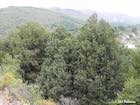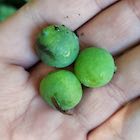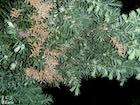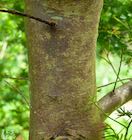Prumnopitys andina
(Poepp.) de Laub. 1978
Common names
Lleuque [Mapudungun] (Mill and Quinn 2001), uva de Cordillera ("grape of the mountains" in reference to the sweet-tasting female cones) (Gardner et al. 2017).
Taxonomic notes
Synonymy (Farjon 1998, Mill and Quinn 2001):
- Podocarpus spicatus Poepp. in Poeppig 1845 non R. Br. 1838;
- Podocarpus andinus Poepp. ex Endl. 1847;
- Prumnopitys elegans Phil. 1860;
- Podocarpus valdivianus J. Nelson 1866;
- Nageia andina (Poepp. ex Endl.) F. Muell. 1876;
- Stachycarpus andinus (Poepp. ex Endl.) Tiegh. 1891;
- Nageia valdiviana (J. Nelson) Kuntze 1891;
- Prumnopitys spicata (Poepp.) Molloy et Muñoz-Schick 1999.
There is an unsolved mystery of biogeography affecting P. andina. In appearance it very closely resembles P. taxifolia, native to the temperate podocarp forests of New Zealand; morphology and, to a degree, molecular data identify a close relationship between the two taxa. The same issue, close similarity in appearance, habitat, and molecular taxonomy, affects the species pair Podocarpus totara of New Zealand and Podocarpus nubigenus of South America. The two areas have not had a land connection since the late Cretaceous, which is a very long time for species pairs to maintain such a close similarity. Their habitat, temperate rainforest, is similar; have they evolved in parallel, or through convergence, or have they simply not changed?
Description
Trees to 21 m tall and 100 cm dbh; crown first conical, later rounded or irregular, with short, ascending branches. Bark thin, dark brown weathering light gray. Leaves in two ranks, angled forward, slightly curved, 15-25 mm×1.5-2.5 mm, base rounded with short petiole, midrib flat above and slightly raised below, apex pointed. Pollen cones in groups of 10-20, each attached on an axillary shoot 10-25 mm long, 5-8×2.5-3 mm. Seed cones 15-20×10-15 mm on a 2-3 cm peduncle, epimatium and seed green maturing deep red-purple. The relatively long leaves with a flat midrib and large seed distinguish it from other species of Prumnopitys (Eckenwalder 2009).
Distribution and Ecology
Argentina. It is sometimes alleged to occur in Chile, Prov. Neuquen, but no specimens have been confirmed to that provenance, and specimens in the field are often confused with Saxogothaea conspicua (Gardner et al. 2017). Grows primarily on well-drained, very nutrient-poor volcanic soils in low to mid-altitude Andean forests from Chile's Región del Maule (35°52'S) to Región de la Araucanía (39°30'S), mostly at elevations of 350-1000 m in small populations of up to a few hundred individuals (Gonzalez 1998, Hechenleitner et al. 2005), although the largest population in Prov. Cautín has approximately 5000 mature trees. The predominant habitat is riparian areas in sclerophyllous evergreen forest, where it seems to be well-adapted to period flooding (Gardner et al. 2017). Based on data from 24 collection localities, its climate preferences include a mean annual temperature of 9°C, with an average minimum in the coldest month of 0°C, and a mean annual precipitation of 1670 mm (Biffin et al. 2011, Table S5). Hardy to Zone 8 (cold hardiness limit between -12.1°C and -6.7°C) (Bannister and Neuner 2001).
The IUCN classifies this species as "Vulnerable" to human impact. The habitat was historically severely exploited by logging, which resulted in widespread, severe, and lasting habitat loss and fragmentation. Although logging has largely been prohibited in native primary forests, ongoing habitat loss persists through both land clearance for agriculture and grazing, and through logging for the woodchip industry (Hechenleitner et al. 2005). The total population is estimated to be about 10,000 reproductive individuals with at least 3 populations of more than 2,000 trees. The primary contemporary threat to the species' continued survival is flooding of Andean valleys by hydroelectric dams; several populations have already
been lost or severely depleted by this activity. Livestock grazing is also a threat, through an unusual mechanism: they eat the fallen seed cones, eliminating regeneration; they also graze the occasional seedling or sapling (Gardner et al. 2017).
Remarkable Specimens
I have no data on trees in habitat. The tallest in cultivation is 20 m, a multiple-trunk tree at Geelong Botanic Gardens in Australia; the largest trunk on this tree appears to be ca. 70 cm dbh. The thickest recorded specimen is a tree 125 cm dbh in Villers-les-Nancy, France; this is a remarkable growth rate for a tree planted in 1968 (Gardner et al. 2017).
Ethnobotany
The sweet-tasting seed cones are consumed by local people and are sometimes used for making a marmalade. The yellowish wood is occasionally used for making furniture and in construction, but it is not a target species for harvest, as are other timber trees native to the Chilean temperate rainforests (Gardner et al. 2017).
Prumnopitys andina is popular and common in horticultural use. It was cultivated in the UK by the 1850s and in the USA by the 1860s; although now found in the USA, Canada, New Zealand, Australia, and quite a few European countries, it has never become common outside of the UK and Ireland. That aggregation includes, besides purely ornamental specimens, ca. 850 trees of precisely known provenance, including all known populations in Chile, that are planted in support of ex situ conservation efforts (Gardner et al. 2017). Gardner et al. (2017) provide detailed notes on propagation techniques.
Observations
No specific locations known, but see the georeferenced collection records at GBIF and iNaturalist (both accessed 2023.02.28).
Remarks
The epithet andina refers to the Andes Mountains.
Citations
Gardner, Martin, Tom Christian, and Dan Luscombe. 2017. Tree of the year: Prumnopitys andina. IDS Yearbook 2017: 23-45.
González, M. 1998. Prumnopitys andina. In: IUCN 2006. 2006 IUCN Red List of Threatened Species. www.iucnredlist.org. Accessed 2006.10.29.
Hechenleitner, P., M.F. Gardner, P.I. Thomas, C. Echeverria, B. Escobar, P. Brownless and C. Martinez. Plantas Amenazadas del Centro-Sur de Chile: Distribución, Conservación y Propagación. Available: http://www.chilebosque.cl/amenazadas.html (accessed 2006.10.29). The principal information on Prumnopitys andina is reproduced as a web page at http://www.chilebosque.cl/tree/prandi.html.
Laubenfels, David J. d. 1978. The genus Prumnopitys (Podocarpaceae) in Malesia. Blumea 24:189-190.
Mill, R.R. and C.J. Quinn. 2001. Prumnopitys andina reinstated as the correct name for "lleuque", the Chilean conifer recently renamed p. spicata (Podocarpaceae). Taxon 50(4):1143-1154.
See also
Encyclopedia de la Flora Chilena: http://www.florachilena.cl/Niv_tax/Gimnospermas/Podocarpaceae/Prumnopitys/Prumnopitys%20andina.htm. Accessed 2006.10.29.
The species account at Threatened Conifers of the World.
Molloy, B. P. J. and M. Muñoz-Schick. 1999. The correct name for the Chilean conifer Lleuque (Podocarpaceae). New Zealand Journal of Botany 37: 189-193.





